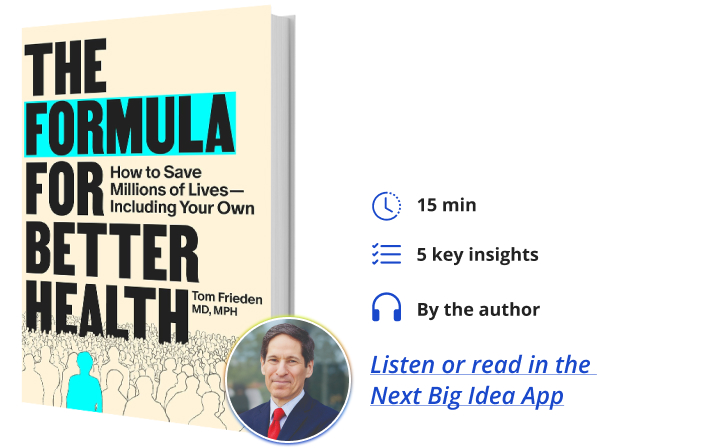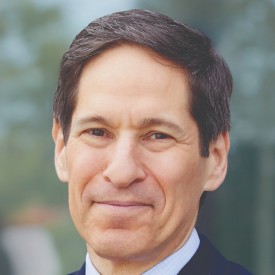Below, Dr. Tom Frieden shares five key insights from his new book, The Formula for Better Health: How to Save Millions of Lives–Including Your Own.
Tom heads a global health organization called Resolve to Save Lives. Previously, he helped stop deadly outbreaks while leading the New York City Health Department and also navigated the threat of Ebola and other diseases during his time as director of the Centers for Disease Control and Prevention under the Obama Administration.
What’s the big idea?
We can do a lot more to avoid the most dangerous and fatal health conditions than we think. To make tragedies like cancer, heart attack, or dementia less likely in your future, you can follow specific, proven strategies. Dr. Frieden sorts out facts from hype to lay out a formula for better health.

1. Many health tragedies are preventable.
Heart attacks, strokes, and many cancers aren’t destiny. Although many conditions can’t be prevented, a surprisingly large share of health tragedies can be delayed or avoided entirely. Up to four out of five early deaths from heart disease and stroke, and two in five cancers, are caused by risks that we already know how to stop. Promoting potassium-enriched, low-sodium salt, reduction of tobacco use, and administration of cancer-preventing vaccines have already driven death rates down rapidly.
2. Learn to see the invisible.
Public health has the superpower of seeing the invisible. It’s possible to reveal trends inside of microbes, disease patterns in communities, toxins, and progress or failure in fighting health threats. We can track the otherwise invisible, but most important, predictors of a long and healthy life. Our blood pressure, lipid, and blood sugar levels, visual and auditory acuity, and physical fitness can be well within the normal range, but nevertheless on trajectories to early disability and death. The normal range is wide and varies among individuals. If you track your personal baselines over time, you can make sensible, practical changes before damage occurs.
3. What seems inevitable often isn’t.
Not so long ago, it seemed normal for a family to hop into their car, pump it full of leaded gasoline, not use seat belts, drive to the beach to sunbathe with tanning oil, have a few drinks, and then smoke cigarettes over dinner. Looking back, the cancers, heart attacks, strokes, and fatal crashes that resulted are unsurprising. Public health action flipped those risks from invisible to unacceptable. Today’s heart attacks, strokes, cancers, and even pandemics aren’t inevitable either. Change seems impossible until it happens.
4. Simple solutions win.
Leonardo da Vinci wrote, “Simplicity is the ultimate sophistication.” Steve Jobs used these words in Apple’s first shareholder letter. Only simple approaches are likely to be implementable at scale. A remarkable man named Dr. Karel Styblo proved that point. I met Styblo early in my career, and he asked me a question that changed my life.
At the time, I oversaw tuberculosis control for New York City, and it was in the midst of a large outbreak of multidrug-resistant tuberculosis. I had been working around the clock for months, but wasn’t making much progress. Styblo reviewed our data and asked me, “Dr. Frieden, last year, your program diagnosed 3,811 patients. How many of them did you cure?” I was terribly ashamed because I didn’t know. The very next day, I started a system to track, hold ourselves accountable for, and improve the care of every single patient in the city.
“Whether you’re improving your fitness, diet, or medicine routine, keep it simple.”
In my current organization, Resolved to Save Lives, we’ve taken that lesson to heart. We built an open-source digital solution called Simple, which works astonishingly well in helping nurses and doctors manage patients’ high blood pressure and diabetes. Work that once meant flipping through paper registers now takes a few taps on a phone, freeing time for patient care and giving managers reliable data to improve performance. Achieving this level of simplicity required sitting with nurses, watching every keystroke, and removing anything that wasn’t essential.
Simplicity matters for personal health, too. Whether you’re improving your fitness, diet, or medicine routine, keep it simple. Combination pills, potassium-enriched, low-sodium salt, and a short list of six evidence-based habits do a lot better than complicated regimens and wellness fads. Simplicity makes scale possible, and scale saves lives.
5. Six habits add healthy years.
First, control blood pressure. With every heartbeat, every second of every day, high blood pressure pounds like a battering ram on artery walls in the heart, brain, kidneys, and throughout the body. The first symptom is often a heart attack or stroke—that’s why it’s called the silent killer. Every 20-point rise in systolic pressure above 115 doubles your risk. So, aim for under 120. More than 90 percent of people in the U.S. over age 65 have unhealthy blood pressure. If you have high blood pressure, take your medication every day and monitor your blood pressure regularly.
Second, reduce unhealthy cholesterol and other lipids. Fatty plaques start clogging arteries in the teenage years, and later in life, they trigger heart attacks, strokes, and disability. The lower the LDL, the lower the danger. Statins and other lipid-lowering drugs are safe, inexpensive, and highly effective. Ask if they’re right for you.
Third, steer clear of tobacco, excess alcohol, and other toxins. Tobacco is still the world’s leading preventable killer. Smokers die about 10 years younger and feel a decade older while alive. Alcohol increases your risk of cancer and harms your heart, brain, nerves, and liver. Lead, soot, and forever chemicals silently damage health. If you use tobacco, quit and use proven cessation medicines—they double success. Swap out alcohol for satisfying alcohol-free alternatives.
“A brisk walk, ideally outdoors, for 30 minutes, four days a week, can do wonders.”
Fourth, perform an enjoyable physical activity every day. Physical activity is the closest thing to a miracle drug, cutting the risk of cancer, heart disease, diabetes, depression, dementia, and more. Whatever your weight, choose activities you enjoy. And if you’re older, consider adding balance exercises to help prevent falls. A brisk walk, ideally outdoors, for 30 minutes, four days a week, can do wonders.
Fifth, eat food that you and your body love. Food choices affect blood pressure, inflammation, the microbiome, and much more. Load up on potassium-rich foods such as sweet potatoes, salmon, avocado, tomatoes, and yogurt. Switch to potassium-enriched, low-sodium salt. Aim to eat more potassium than sodium and avoid added sugars.
Sixth, prioritize sleep. During sleep, the body repairs damage, consolidates memory, and keeps immunity sharp. Too little or low-quality sleep raises the odds of obesity, diabetes, heart disease, depression, and dementia. Protect at least seven hours of sleep by setting a regular bedtime, getting off screens an hour beforehand, and keeping your room dark and cool.
Enjoy our full library of Book Bites—read by the authors!—in the Next Big Idea App:






























